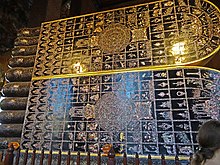Wat Pho
Wat Pho ( Thai วัด โพธิ์ ) is a First Class Royal Temple , a Buddhist temple ( Wat ) , located in the center of the historic old town of Bangkok (see Rattanakosin ), immediately south of the Royal Palace . Its official name is Wat Phra Chettuphon Wimon Mangkhalaram Ratchaworamahawihan ( วัดพระเชตุพน วิมล มังคลาราม ราชวรมหาวิหาร ), but locals still call it Wat Pho after its historical name Wat Photharam , which is supposed to remind of the monastery of the Bodhi tree in Bodhgaya .
Since Wat Photharam was already mentioned in the Ayutthaya Chronicle during the reign of Phra Petracha , it is likely to have been founded as early as the 17th century. To establish his new capital Bangkok, King Rama I restored and expanded the temple (which lasted from 1789 to 1801) and gave it its current name. All other kings of the Chakri dynasty also expanded and restored this royal temple (Wat Luang) .
Attractions

-
Phra Ubosoth : the Ubosot was built by King Rama I. Inside it is Phra Phuttha Thewa Patimakon , a seated Buddha statue in Ayutthaya style. The remains of King Rama I were buried in its base.
- The balustrade around the ubosot shows 152 square reliefs on its outside that represent the Ramakien . They were commissioned by King Rama III. placed here when he rebuilt the Ubosot. The origin of the reliefs is not known. In the beginning, resourceful traders sold so-called "temple rubbings" of these reliefs on thin paper. Since the plates were damaged too much, this practice has not been permitted since 1965.
- Viharn of the Reclining Buddha : The main attraction today is the famous 46 meter long and 15 meter high gold-plated reclining Buddha statue . In Thailand there are numerous, huge statues of reclining Buddhas, for example in the temple Wat Khun Inthapramun , Ang Thong province (50 meters long, made of bricks covered with stucco). In the temple Wat Bang Phli Yai Klang in the province of Samut Prakan there is a 53-meter-long specimen that is even accessible.
- Phra Maha Chedi Si Ratchakan : This group of four chedis is visible from afar , each 42 meters high and covered with different-colored mosaics of tiles. The first was built by King Rama I and contains the remains of the Buddha statue "Phra Si Sanphet", which was destroyed by the Burmese during their attack on Ayutthaya in 1767. The second and third chedi were made by King Rama III. erected as a symbol of the reign of his father and his own. This group of three chedis should be reminiscent of a similar group at Wat Phra Sri Sanphet in Ayutthaya . The fourth chedi, covered with blue tiles, was commissioned by King Mongkut (Rama IV) in 1853 to praise the Buddha. The Phra Chedi Sisuriyothai in Ayutthaya, which was built by King Maha Chakkraphat in honor of his Queen Si Suriyothai , served as a model .
- "Open University" : King Rama III. During the renovation of Wat Pho in the years 1831–1841, over 1400 wall inscriptions and paintings were attached, which recorded Thai poetry, treatises on traditional healing arts and massage, botany, astrology, martial arts, history and religion, as well as the provinces and religious institutions of that time of the empire as well as foreign peoples. These were open to the public and can therefore in some ways be described as a first, open university in Thailand. That is why Wat Pho is particularly considered a place for the preservation and dissemination of traditional Thai medicine and Thai massage . Since 2011 the “epigraphic archive” of Wat Pho has been part of the UNESCO World Document Heritage.
- Impressions from the temple area
Some of the 71 Chedi Rai
A guardian figure in one of the 4 prangs in the courtyard
literature
- KI Matics: A History Of Wat Phra Chetupon And Its Buddha Images . The Siam Society, Bangkok 1979 (only available in second-hand bookshops)
Web links
- Wat Pho
- Wat Phra Jetuphon ( Memento from January 25, 2017 in the Internet Archive ) - history and “virtual tour” through today's temple
- The footsteps of the Buddha ( Memento from February 2, 2017 in the Internet Archive ) - Description of the individual mother-of-pearl images on the soles of the feet of Phra Norn, the Great Reclining Buddha
- Wilfried Stevens: Wat Pho in Bangkok. onlinezeitung24.de, April 2, 2015
Individual evidence
- ↑ KI Matics: A History of Wat Phra Chetupon and its Buddha Images . The Siam Society, Bangkok 1979
- ^ Epigraphic Archives of Wat Pho . UNESCO Memory of the World; accessed on February 9, 2016.
Coordinates: 13 ° 44 ′ 46.3 " N , 100 ° 29 ′ 38.4" E












